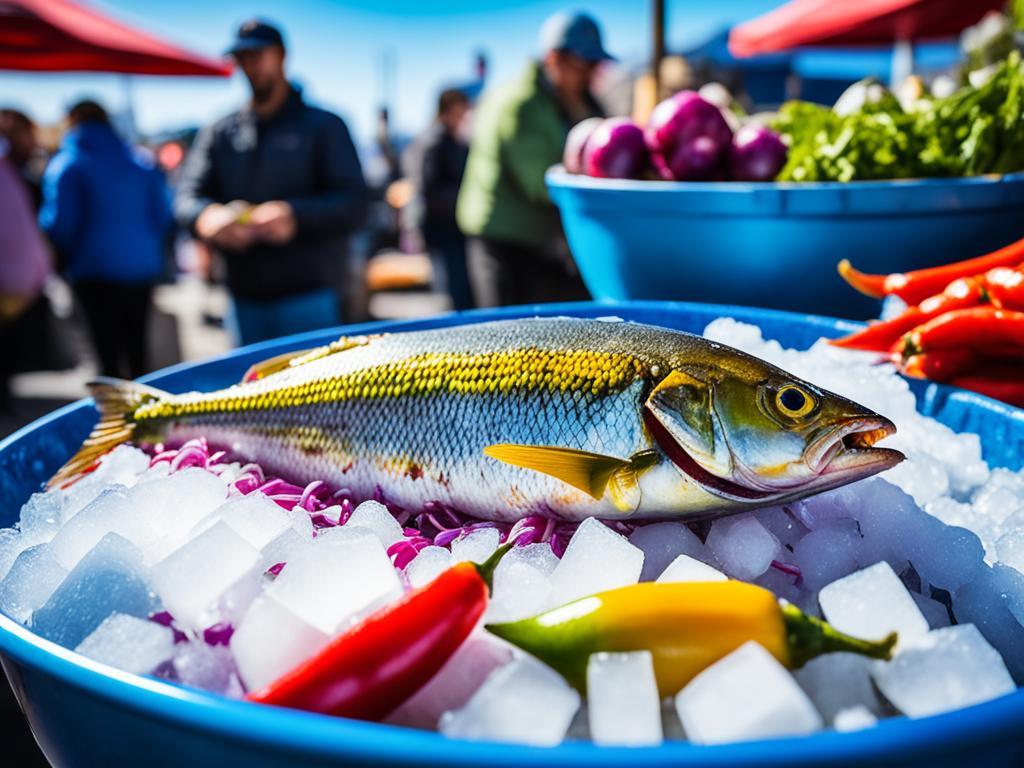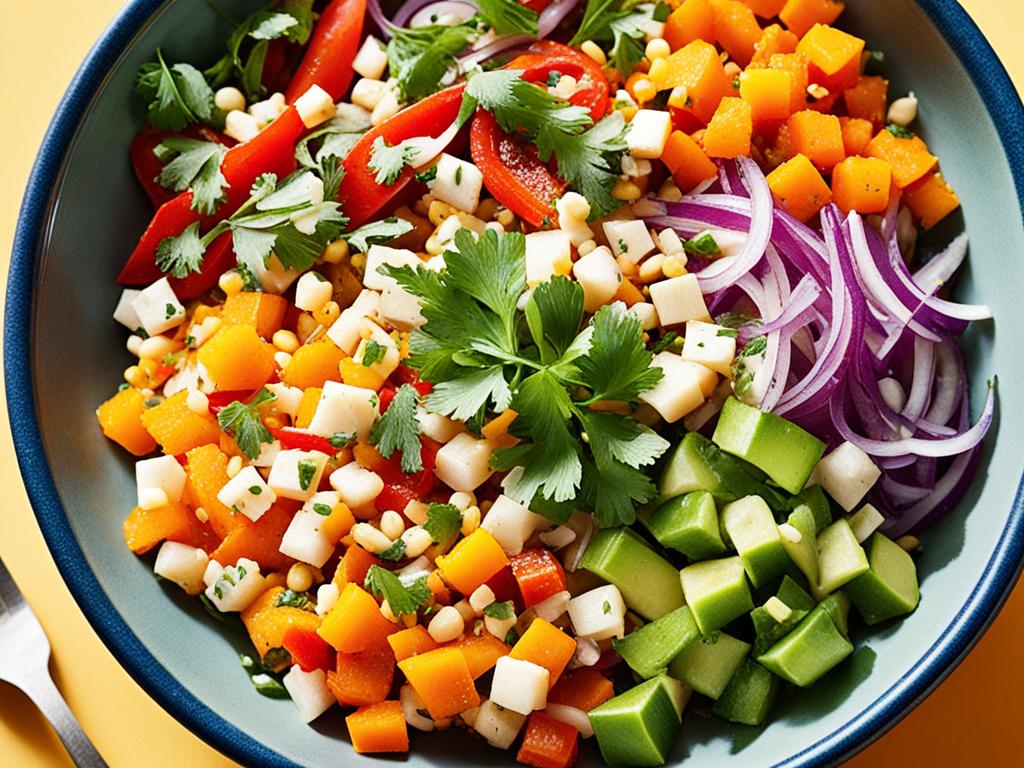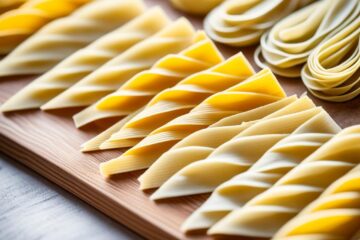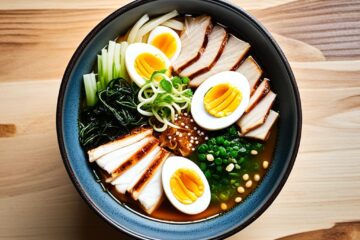Imagine you’re at a sunny beach in Peru. A soft breeze brushes your face. The ocean view is breathtaking. Waves crash, creating a natural symphony. The sun’s warmth wraps around you. You smell something delicious, pulling you closer.
You see a stunning plate of Peruvian ceviche. This dish looks as good as it tastes. The fish, marinated in lime, is tangy and fresh. It’s a taste of Peru’s culture, inviting you on a culinary journey.
Peruvian ceviche’s story is long and rich. It comes from the heart of Peru’s traditions. Through the years, it’s become key in Peruvian food. It tells a story of the coast and a love for seafood. This tradition started thousands of years ago, when people first marinated fish in citrus.
Today, Peruvian ceviche is known worldwide. This dish’s influence shows in its vibrant look and bold taste. Chefs everywhere love to put their twist on it. It’s loved in Peru and beyond. It’s a thrill for anyone who loves great food.
Key Takeaways:
- Peruvian ceviche is a visually stunning and delicious seafood dish.
- It is deeply rooted in the traditions and culture of Peru.
- The dish has evolved over thousands of years and is now celebrated worldwide.
- Peruvian ceviche reflects Peru’s coastal identity and love for seafood.
- Its vibrant colors, bold flavors, and innovative techniques make it a culinary masterpiece.
Exploring the Flavors of Ceviche (Peru)
Ceviche bursts with flavor, making it a top choice for exciting your taste buds. It comes from Peru and is a favorite in Latin American food.
The beauty of ceviche is its simplicity. It features fish soaked in lime, giving it a zesty, cold “cooked” taste. The lime actually “cooks” the fish because of its high acidity, with no heat needed.
Latin America’s cuisine is famous for its strong, diverse tastes. This influence is clear in ceviche, combining native ingredients, European methods, and African seasonings. This mix makes ceviche stand out among seafood dishes.
Want to make your own ceviche? Here’s a basic recipe to guide you:
Ingredients:
- 1 pound fresh white fish fillets, such as sea bass or snapper
- 1 cup freshly squeezed lime juice
- 1 red onion, thinly sliced
- 1 jalapeño pepper, seeded and finely chopped
- 1/2 cup chopped cilantro
- Salt and pepper to taste
Instructions:
- Cut the fish into bite-sized pieces and place them in a glass or ceramic bowl.
- Pour the lime juice over the fish, making sure it is completely covered. Let it marinate in the refrigerator for at least 30 minutes.
- Add the sliced red onion, chopped jalapeño pepper, and cilantro to the bowl. Season with salt and pepper.
- Gently mix all the ingredients together, ensuring the fish is evenly coated. Refrigerate for an additional 15 minutes to let the flavors meld.
- Serve chilled and enjoy!
By following these steps, you’ll be able to enjoy the rich taste of ceviche at home. Take this journey to Peru through your taste buds and see why ceviche is loved worldwide.
Traditional Ceviche Techniques and Variations
Making traditional ceviche demands careful attention. Crafting this Peruvian favorite needs the right technique. The key is using fresh ingredients and a good marinade to get the perfect taste.
The traditional method of making ceviche keeps its core but adds local twists. It involves marinating raw seafood in citrus juice to ‘‘cook’’ it. This makes a dish full of flavor that is both tender and zesty.
The marinating process changes depending on the type of seafood. Light fish like sole or flounder only need 15-20 minutes. But, bigger fish like halibut can marinate up to an hour. The lime juice not only flavors the fish but also makes it safe to eat.
Ceviche varies a lot across Peru, showing its diverse culture. In Lima, on the coast, it’s mostly raw fish with lime, onions, and hot peppers. Yet, in the Andes, it might have shrimp or octopus with its own special seasonings.
A Culinary Delight in Every Bite
Ceviche’s many forms highlight Peru’s rich food culture. Whether by the sea or in the mountains, each bite is a delight.
“The mix of fresh seafood, zesty lime, and lively herbs make Peru’s coastal tastes come alive.”
If you enjoy Lima-style ceviche or want something different, there’s much to explore. Learning about the traditional ways lets you dive into Peru’s food history.
For more on the history of this dish, explore this National Geographic article on ceviche.

Conclusion
Peruvian ceviche is more than just a dish; it’s a star in the Latin American food scene. Its zesty fish and lime mix make it unique. This dish represents the taste and traditions of Peru, showing off its rich food culture.
We’ve learned that Peruvian ceviche is loved worldwide. Its zest and the seafood’s freshness balance perfectly. It’s a hit, whether sold on the street or at fancy eateries, winning over anyone who tries it.
If you find Peruvian ceviche interesting, check out its story and cultural value. UNESCO recognizes its cultural importance. Discover its roots and how Peruvians, rightly so, cherish it as a national gem.
Ready for a new taste adventure? Whether you’re a ceviche fan or just getting started, don’t miss out. Peruvian ceviche will make your taste buds happy and our senses come alive.




